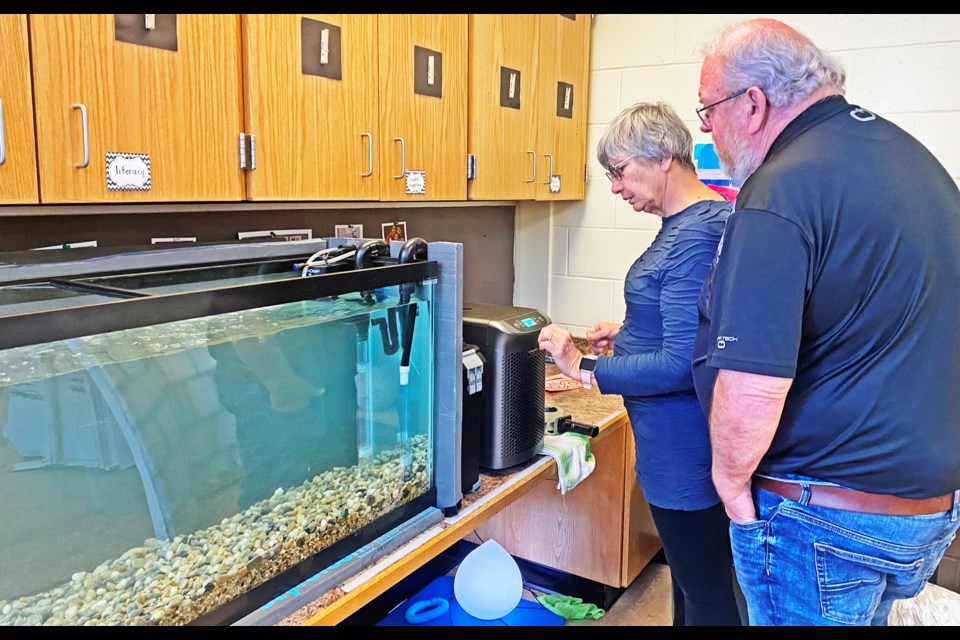WEYBURN - Two Weyburn classrooms are watching the cycle of life in the form of Rainbow trout eggs, hatching and growing into fingerlings, through the FINS (Fish in Schools) program from the Saskatchewan Wildlife Federation.
“This program was created by the Saskatchewan Wildlife Federation in cooperation with the hatchery in Fort Qu’Appelle,” explained Larry Olfert of the Weyburn Wildlife Federation.
The Weyburn branch applied for a grant to take part in the program, and provided $1,800 to buy two 100-gallon aquariums and the related supplies, one for a class at St. Michael School and one at the Weyburn Comprehensive School.
In addition, the Weyburn Wildlife Federation arranged for the SWF’s fishery technician in Moose Jaw, James Villeneuve, to provide the supplies, including the proper filtration and gravel needed for the trout eggs to survive and grow.
Villeneuve also provided a step-by-step guide of what to do for each stage of development after the eggs hatched, said Olfert.
He and wife Judy helped to set the tanks up, which was not an easy process, noted teacher Candice Porter at St. Michael School. “They were a huge support in setting things up. There are many pieces, including the filter, chiller, tank, underwater gravel filter, etc.”
“If they have any problems, we try to assist in any way we can,” said Olfert. “It is extra work for them, so we really appreciate the work the teachers do.”
“We received 100 rainbow trout eggs on Feb. 2 from the FINS (fish in schools) program through the Saskatchewan Wildlife Federation,” said Porter. “We were fortunate to get the financial support to make it happen through the Weyburn Wildlife Federation.”
Asked how the students reacted to having a live fish tank in their class, she replied, “The students were quite intrigued when the eggs came. One hundred eggs doesn’t look like very much in such a large tank. The excitement started when the eggs started to hatch and again once the eggs alevins were released into the full tank.”
These are tiny fish with the yolk sac of the egg attached to their bellies. When they have consumed all of the yolk sac and grown in size, these fish emerge from the gravel, and are then considered fry. The first day the students began feeding the fish was on March 5th, more than a month after receiving the eggs.
“Up until then, they fed off the attached egg sac. Moving forward, the students responsibilities and learning will increase. Each day, my classroom leader will be responsible for feeding, and twice a week the students assist with changing water to keep it clean and healthy for the fish to grow,” Porter explained.
“We will continue to learn and care for the rainbow trout until June when they are released into the trout pond at Mainprize.”
At the Comp, teacher Cody Paterson had hoped to have the fish eggs in time for his Wildlife Management 20 class to see and learn from the experience, but this class only ran in the first semester, and the fish eggs didn’t arrive until the first week of February, which was the start of the second semester.
Paterson said this still works well, and is hoping to get the word out about the fish to as many classes as possible.
“The rainbow trout are not just for one specific class but to be enjoyed by all students at WCS. The rainbow trout have just recently started swimming around and eating food which is the fun stage. Student interest has definitely gone up but word is still getting out in the school and I hope more teachers will bring their classes down to enjoy them, he said.
“So far students from Communications Media 20/30 have been coming down periodically to take pictures of the progressing stages of the trout from eggs alevin to fry stage. They will be using these pictures to practice professional editing skills and eventually put together a slide show as one of their assignments in the class,” he added.
“Many students from the FIP classroom have come down for a visit and hope they can help out with feeding the trout more in the future. Students from Adventure Club have also started coming to look at the trout and I hope as word gets around that more and more teachers in the school are able to come down and tie in curricular outcomes to their classes.
“Right now the trout live in the Electrical Lab where I mainly teach and am able to directly supervise them throughout the day and facilitate the many drop-ins that are always welcome,” said Paterson, noting that some of his Wildlife Management students still want to be involved in studying and caring for the trout.
“As the fish have just started eating this week we haven’t figured out a solid schedule for feeding and water changes just yet. However many students from my Wildlife Management 20 class last year and this year have offered to help out and are currently putting together a plan.”




